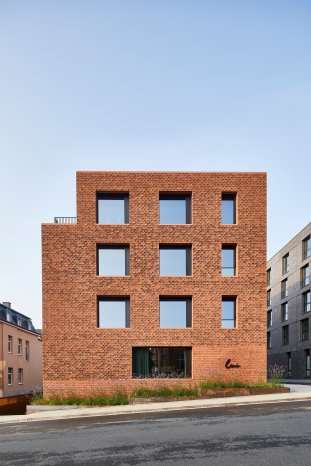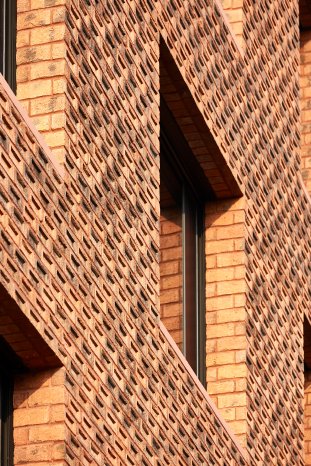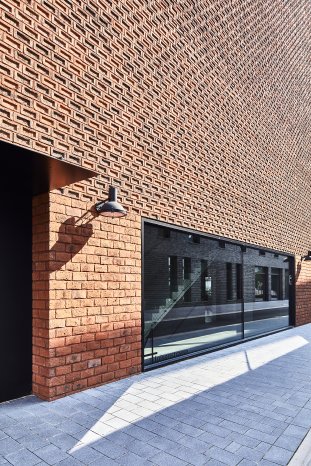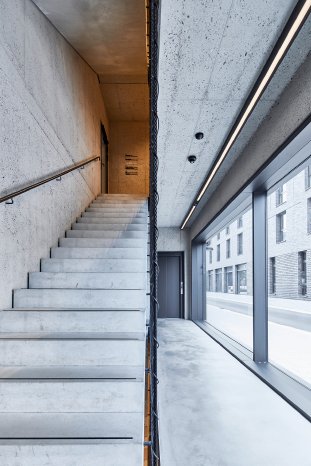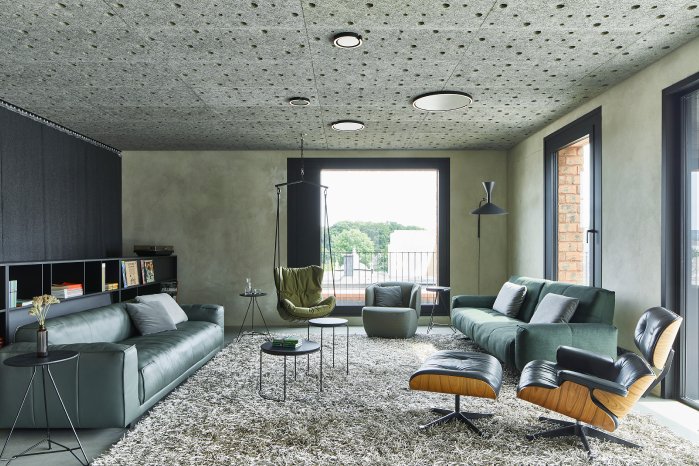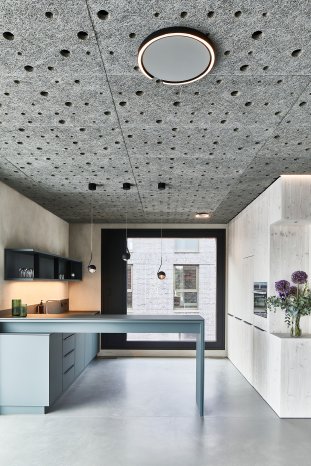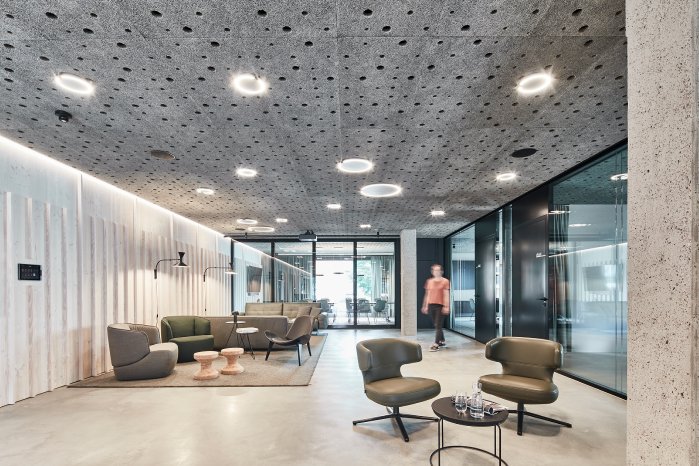The most well-known providers of co-working spaces in Germany are Design Offices, WeWork and Regus. And LUI House looks likely to join these names in the near future. The brand LUI House stands for excellence in design, facilities and sustainability - at least that is how its founder and owner Karsten Monke sees it. Monke is also the owner of Herford-based architectural practice archwerk, which designed the building. With LUI House, he and his team created a prototype of an energy-efficient and sustainable co-working space. The four-storey newbuild lies in the heart of Herford and directly neighbours the Marta Herford museum, the Elsbach textile factory, and the Steigenberger Intercity Hotel. The building offers small companies, sole traders, and start-ups an inspiring place to work, as different players from a variety of industries come to the space to work on diverse projects. Besides conventional office rooms, there are co-working spaces, conference rooms, lounge areas, a Creative Lab, and a public café.
A modern working environment across four floors
On the ground floor, anodised black steel canopies mark both the main entrance and the entrance to the public café. Entering through either side will take you to the central lounge, which leads to five conference rooms of different sizes, each of which can accommodate between six and sixteen people. On the first floor, co-working spaces are complemented by ten individual office rooms, which each offer between one and four work stations. There is a lounge here too, albeit slightly smaller than the one on the ground floor, as well as a small kitchen. Architectural practice archwerk occupies the second floor. The 24 architects and engineers who currently work at the practice have access to different types of rooms and work stations. Besides a variety of office rooms, small work cubicles and telephone booths, this floor also includes informal areas and a quiet room. The design quality of the building is reflected both in its exterior and interior design. LUI House is home to classics such as an Eames Ottoman and a Le Corbusier 'Projecteur', used as an external light feature and commissioned in a special colour unique to LUI House.
A digital world with vision
With an area of 200 m2, the Creative Lab on the third floor is the largest room in the building and can be used for workshops or lectures. Amongst other features, the Lab is equipped with a fully digital noticeboard. This 'idea wall' can act as a screen on which to display information and can also be used in layers. Leaving the Creative Lab, you will find yourself on the 140 m2 roof terrace, which offers sweeping vistas over the hills of Herford and also extraordinary views over the roof of the neighbouring Marta Museum, designed by Frank O. Gehry. The terrace is equipped with an outdoor kitchen and BBQ.
Sustainability and energy efficiency
The office building's high-quality design is uniquely mirrored in its sustainable energy concept. A life cycle analysis was carried out to calculate the building's expected life cycle costs. The only thing the building buys is drinking water. Other than that, a 16.5 kWp photovoltaic system provides almost all of the energy required in the building. At peak times or when the sun is down, electricity can also be sourced from the national grid. The photovoltaic system is connected to two ground source heat pumps, which are used for heating and cooling. Concrete core activation in the floors allows for cooling, while underfloor heating provides necessary warmth. The ventilation system has a heat recovery level of over 90 percent, with exhaust air warming fresh air via a cross-flow heat exchanger. Other technical features include a shading system which moves in accordance with the position of the sun; a lighting system which can be controlled by Bluetooth; and two Wallbox EV chargers. Even the toilets are electronic bidets featuring driers. All of these important functions and systems are fully integrated in the building's design.
Interesting shapes with Danish clinkers
The building's façades, made of handcrafted Danish clinkers, are reminiscent of industrial buildings from the 1920s and 1930s. These clinkers bring the bricklaying tradition of this time period up to date. The unconventional laying of the bricks upright on their edge with the indentation facing outwards lends the upper façade storeys an appearance of depth. Normally, the bricks are laid horizontally in the wall so that their indents are hidden and filled with mortar. On LUI House, however, these indents become a purely ornamental design feature. In the lower sections of the façade, the clinkers are laid flat in the conventional method with their indents hidden. A particular challenge was making sure that no clinkers were cut. The dimensions of the building and its windows and pillars were calculated so that every brick used was whole.
Façade, window and door systems
Several Schüco window types and systems are featured in the façade. On the inside, the dark metal profiles of the windows act as a kind of picture mount. The window units here are flush with the plaster. This means that there is a notable reveal depth on the outside, creating a strong appearance of depth. The dimensions of all the windows were calculated so as to fit with the clinker dimensions (228 x 85 x 108 mm), ensuring that no clinkers had to be cut. The upper floors feature two versions of the AWS 75.SI aluminium profile series with flat metal profiles: large, almost square-shaped windows (around 2.45 x 2.45 m), and narrow side-hung vents (around 1.20 x 2.45 m) with slim face widths. All of the square-shaped windows include a 12 cm high ventilation gap along their upper edge, which can be manually opened to aid user comfort. Meanwhile, the FWS 50.SI mullion/transom system supplies the eight-metre stairwell with as much daylight as possible. ASE 67 PD Panorama sliding doors were chosen for the entrances to the roof terrace and to the public café. The doors slide in both directions to allow for a bright, 3.5 m wide opening, so the transition from the indoors to the outdoors is fluid. The door profiles have minimal face widths of just 30 mm and, like the windows, were provided by Schüco. The access doors connecting to the stairwell belong to the ADS 80 FR 30 series of fire-resistant aluminium doors, while the AD UP 75 system was used for the entrance door. The doors meet notably high safety requirements, including the burglar resistance class RC2N.
Project details
Location: Luisenstraße 4, 32052 Herford
Client: Lana Holding GmbH, Herford
Users: archwerk GmbH, Herford and others
Architect: Karsten Monke, archwerk GmbH, Herford
Window fabricator/Schüco fabricator: ALUBA Aluminiumbau GmbH & Co. KG, 32120 Hiddenhausen
Schüco products/materials installed:
- Door system: Schüco AD UP 75 (Aluminium Door Universal Platform, 75 mm basic depth).
- Panorama sliding system: Schüco ASE 67 PD (Aluminium Sliding Element, 67 mm basic depth, Panorama Design).
- Mullion/transom façade system: Schüco FWS 50.SI (Aluminium façade system, 50 mm face width, Super Insulated).
- Window system: Schüco AWS 75.SI+ (Aluminium Window System, 75 mm basic depth, Super Insulated).
- Ventilation vent: Schüco AWS 75 PD VV.SI (Aluminium Window System, 75 mm basic depth, Panorama Design Ventilation Vent Super Insulated)
- Fire system: Schüco ADS 80 FR 30 (Aluminium Door System, Fire Resistant, 80 mm basic depth, fire resistance class EI30 (T30/F30) and EW30 (G30)).
Completion date: November 2020
www.schueco.com/inow
www.lui.house

